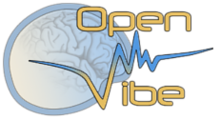OpenVibe
This article needs additional citations for verification. (April 2010) |
 | |
| Developer(s) | OpenViBE Developers |
|---|---|
| Initial release | March 21, 2007 "InriaForge project website". Retrieved 11 June 2016. |
| Stable release | 1.3.0
/ December 30, 2016[1] |
| Written in | C++ |
| Operating system | Linux, Windows |
| License | AGPL |
| Website | openvibe |
OpenViBE is a software platform dedicated to designing, testing and using brain-computer interfaces. The package includes a Designer tool to create and run custom applications, along with several pre-configured and demo programs which are ready for use.[2][3][4][5][6]
OpenViBE is software for real-time neuroscience (that is, for real-time processing of brain signals). It can be used to acquire, filter, process, classify and visualize brain signals in real time.
Applications
[edit]The main OpenViBE application fields are medical (assistance to disabled people, real-time biofeedback, neurofeedback, real-time diagnosis), multimedia (virtual reality, video games), robotics and all other application fields related to brain-computer interfaces and real-time neurosciences.
OpenViBE users can either be programmers or people not familiar with programming. This includes medical doctors, video game developers, researchers in signal processing or robotics, etc.
Since 2012, the start-up Mensia Technologies has developed an advanced version of the software called NeuroRT Suite.[7]
Interface
[edit]The user interface of OpenVibe is easy to use for creating BCI scenarios and saving them for later use, to access and to manipulate. OpenVibe is the first library of functions written in C++ of this type developed by INRIA - Institut national de recherche en informatique et automatique (France) - it can be integrated and applied quickly and easily .
See also
[edit]References
[edit]- ^ "OpenViBE release note". Retrieved 11 February 2017.
- ^ OpenViBE: Open-Source Software for Brain-Computer Interfaces ERCIM News, accessed March 2011
- ^ Ahirwal, Mitul Kumar; Londhe, Narendra D. (July 2011). "Offline Study of Brain Computer Interfacing for Hand Movement Using OpenVIBE". 2011 International Conference on Process Automation, Control and Computing. pp. 1–5. doi:10.1109/PACC.2011.5978930. ISBN 978-1-61284-765-8. S2CID 17627400.
- ^ Lindgren, Jussi; Lecuyer, Anatole (2016), "OpenViBE and Other BCI Software Platforms", Brain–Computer Interfaces 2, John Wiley & Sons, Ltd, pp. 179–198, doi:10.1002/9781119332428.ch10, ISBN 978-1-119-33242-8, retrieved 2021-05-30
- ^ ME, Cédric Arrouët; PhD, Marco Congedo; PhD, Jean-Eudes Marvie; PhD, Fabrice Lamarche; PhD, Anatole Lécuyer; PhD, Bruno Arnaldi (2005-07-08). "Open-ViBE: A Three Dimensional Platform for Real-Time Neuroscience". Journal of Neurotherapy. 9 (1): 3–25. doi:10.1300/J184v09n01_02. ISSN 1087-4208.
- ^ Renard, Yann; Lotte, Fabien; Gibert, Guillaume; Congedo, Marco; Maby, Emmanuel; Delannoy, Vincent; Bertrand, Olivier; Lécuyer, Anatole (2010-02-01). "OpenViBE: An Open-Source Software Platform to Design, Test, and Use Brain–Computer Interfaces in Real and Virtual Environments". Presence: Teleoperators and Virtual Environments. 19 (1): 35–53. doi:10.1162/pres.19.1.35. S2CID 6345088.
- ^ "Digital Brain Therapy for ADHD".
External links
[edit]- Project homepage
- "Now, you can control computer commands by thought" The Economic Times, accessed March 2011
- "Brainwaves put patients in touch" BBC News, accessed March 2011
- "OpenViBE: An Open-Source Software Platform to Design, Test, and Use Brain–Computer Interfaces in Real and Virtual Environments" MIT Press Journal "Presence," February 2010, Vol. 19, No. 1, Pages 35–53
